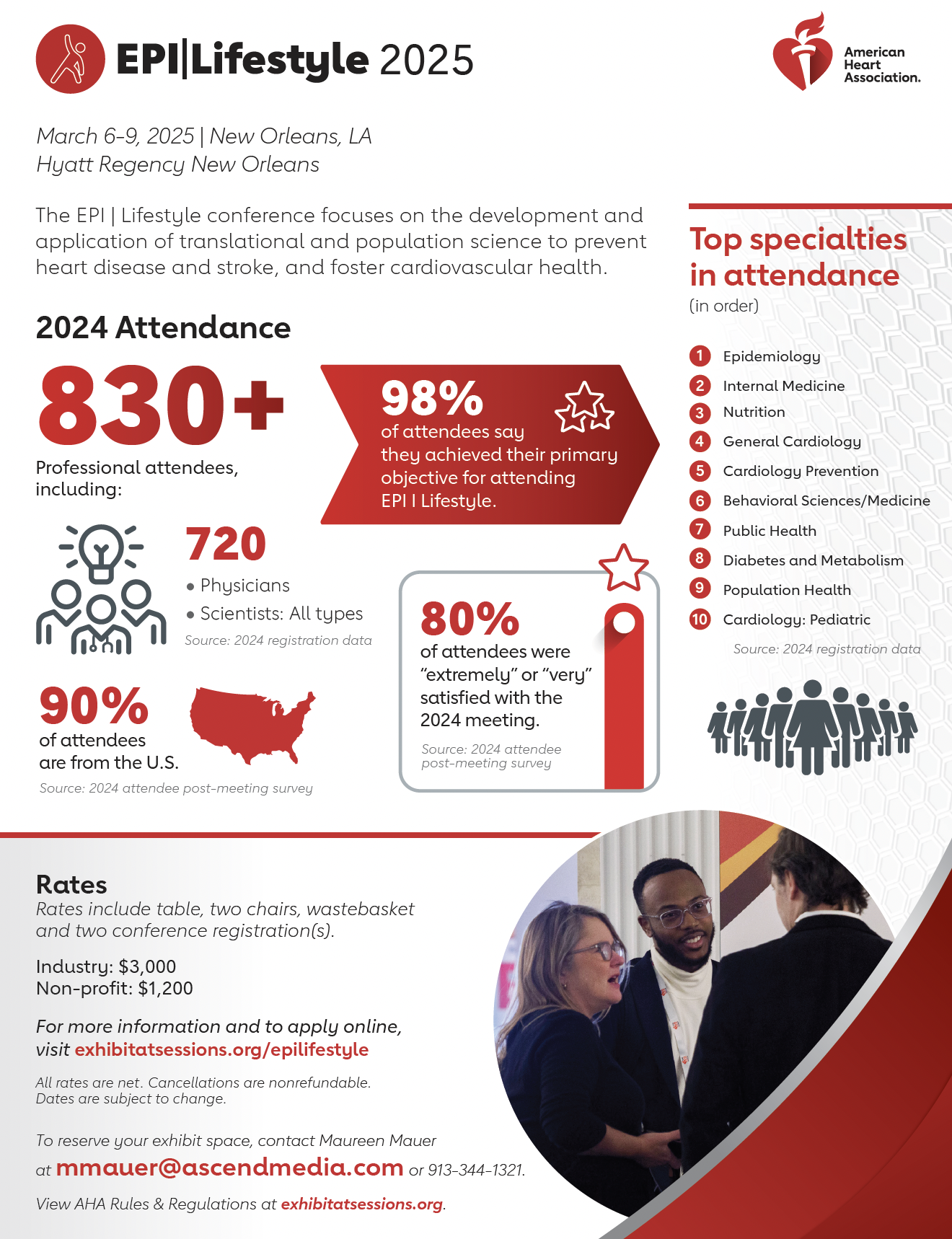The term Unofficial Satellite Events (USE) refers to any activity which is independently organized offered, and/or accredited by an organization other than the American Heart Association (AHA), American Stroke Association (ASA); and held before, during or after an AHA/ASA Scientific Conference.
You must be a current exhibitor, university or non-profit organization to hold an Unofficial Satellite Event at any AHA/ASA Scientific Conference with the exception of Symposia Event Holders.
Please note that exhibits, table tops, poster sessions and/or breakout sessions are permitted at Symposia Events only.
Please refer to the Unofficial Satellite Event Scientific Conference Rules and Regulations for further governing restrictions. All event applications are subject to the approval of AHA/ASA Show Management based on the event definitions outlined below.
All Unofficial Event application fees are non-refundable.
The AHA is not responsible for attendance/audience generation or guaranteed attendance levels at Unofficial Satellite Events.
The AHA does not control topics/titles, please check the website for the most up to date list of topics/titles.
The AHA reserves the right to change the USE Process, date, times, procedures, # of slots and any other aspect of the process.
Committee Meetings
Committee Meetings may be held by committees, task forces, boards of universities or non-profit organizations only. Committee meetings are limited to committee members. Estimated attendance is generally no more than 50 attendees and is invitation only from the event holder. Access to AHA/ASA USE approved promotional opportunities and attendee list are not permitted for promotion of Committee Meetings.
Focus Groups
Focus groups target a specific group of attendees to obtain specific data. Estimated attendance is generally no more than 30 attendees and is invitation only from the event holder. Access to AHA/ASA USE approved promotional opportunities and attendee list are permitted and encouraged for promotion of Focus Groups.
Hospitality Suites and/ Staff Meeting Rooms
Hospitality Suites are used to greet invited attendees and/or provide a hospitality lounge. Estimated attendance is generally no more than 30 attendees and is invitation only from the event holder. Access to AHA/ASA attendee list is not permitted for promotion of Hospitality Suites.
Staff Meeting Rooms are rooms used for exhibiting and/or event organizing staff to hold staff meetings. Estimated attendance varies for this type of meeting and is invitation only from the event holder and/or exhibitor. Access to AHA/ASA USE approved promotional opportunities and attendee list are not permitted for promotion of Staff Meetings.
A special note regarding sleeping suites. Sleeping suites are not permitted for these types of events. All companies wishing to secure sleeping suites must go through the AHA/ASA Exhibitor Housing Process.
Investigator Meetings
Investigator Meetings provide an opportunity for investigators to network and share the latest scientific data on clinical trials. Media are not permitted to attend investigator meetings. Estimated attendance varies and is invitation only from the event holder. Access to AHA/ASA USE approved promotional opportunities and attendee list are not permitted for promotion of Investigator Meetings.
Abstracts or manuscripts accepted for presentation at ASA/ASA scientific meetings or in an ASA journal may not be presented at other meetings or published in other journals prior to the embargo time set forth by the AHA/ASA. Please visit the AHA/ASA Embargo Policy found in the USE Scientific Rules and Regulations.
Media Events
Media Events are any events directed to the news media and/ or that one or more members of the media have been invited to attend and where information about a company’s products, services, research finding, studies, etc., is released either formally or informally. Estimated attendance varies and is invitation only from the event holder. Access to AHA/ASA USE approved promotional opportunities and attendee list are not permitted for promotion of Media Events.
Abstracts or manuscripts accepted for presentation at AHA/ASA scientific meetings or in an AHA/ASA journal may not be presented at other meetings or published in other journals prior to the embargo time set forth by the AHA. Please visit the AHA/ASA Embargo Policy found in the USE Scientific Rules and Regulations.
Social Events
Social events include receptions, meet and greet functions, dinners, etc. Educational activities are not permitted at Social Events. If a Social Event is held in conjunction with an educational program, they must be classified as a Symposium. Estimated attendance varies. Access to AHA/ASA USE approved promotional opportunities and attendee list are permitted and encouraged for promotion of Social Events.
Social events for organized dinners and Exhibiting companies taking existing clients to dinner at a public restaurant of less than 15-20 people need not apply.
Symposia
Symposia events are promotional or educational functions that may or may not offer CME accreditation.
The following activities are permitted at symposia events
- Meals and/or Break Refreshments
- Non-Accredited Promotional Events
- CME Accreditation. AHA/ASA does not provide CME accreditation for Symposia. Sponsoring organizations must obtain CME accreditation on their own.
- Breakout Sessions – Only one application per day is necessary if the event is being held within the same facility.
- Exhibits, Table Tops and/or Posters
Estimated attendance is generally no more than 250-300 professional attendees. Access to AHA/ASA USE approved promotional opportunities and attendee list are permitted and encouraged for promotion of Symposia’s.
Non-profits or Universities who have received or anticipate receiving industry funding to organize a Symposia and/or Social Event must apply under the industry supported rate. AHA/ASA reserves the right to collect the additional application fees if a non-profit or university receives industry funding after application approval has been granted.

